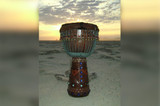Does Earth Have its Own Beat?
In urban and suburban areas, the sounds of traffic and people and technology can be considered the pulse of the earth. These sounds punctuate the day as people attend business meetings, enjoy lunches with friends and unwind while watching evening television. These same people often retreat to more rural areas for vacations and getaways in order to escape a fast-paced, demanding lifestyle and reconnect with nature and the earth to reduce stress and relax. Aside from leaving behind responsibilities and daily to-do lists, this communing with nature provides another benefit: synching the rhythm of the brain with the pulse of the earth.
In 1952, Professor W.O. Schumann of the University of Munich discovered that the space between the earth’s crust and ionosphere (upper atmosphere) produces a vibrational frequency fed through the occurrence of lightening. This frequency, documented to range from six to 50 cycles per second, has been linked to the same frequency recorded in EEG tests on the human brain, particularly the Alpha (meditation/relaxation) and Theta (dreams/creativity) states. This research, named Schumann Resonances, seems to conclude that the earth has a pulse that can be affected by natural occurrences, whether through changes in climate, sunspots or changes in the earth’s magnetic field, among other phenomena.

Schumann Resonances can be easily translated into pulses and beats. At six cycles per second, the frequency is loosely translated into 180 beats per minute, considering the pulse accounts for a beginning and ending. These same pulses can be recreated through music and drumming, rousing a similar effect that reaches the Alpha and Theta waves of the brain. Higher frequencies produce faster beats, which may point to the preference for songs with slow, medium or fast tempos depending on the different moods or needs of the person. For instance, when stressed or anxious, humans turn to music in order to unwind or relax. While exercising, fast-paced music with a strong beat is typically played to help motivate the body and brain.
Music therapists use music and drumming in order to stimulate the brains of those affected by emotional, mental or physical disorders. The popularity of drum circles and drumming for stress reduction or healing can be directly related to Schumann Resonances, tapping into these natural rhythms on a level that is fun, creative and potentially easier to access than a vacation in the mountains.
Whether through a walk in the woods, a beach excursion, or drumming on a Djembe, the connection between the brain and the earth can be found in rhythm. It is this musical association that can provide a road to happier lives, providing wellness, healing and relaxation to those surrounded by a world filled with the artificial pulses of modern living.
Recent Posts
-
What is the Best Size Djembe for Beginners?
If you're new to the world of percussion and interested in learning the djembe, you're in for a t …16th Jul 2024 -
The Benefits of Becoming a Drumming Teacher: Transforming Passion into Profession
Why become a drumming teacher? Becoming a drumming teacher is an excellent way to share your pas …22nd May 2024 -
What Makes the Djembe Drum a Spiritual Instrument in African Music?
Origin and history of the Djembe drum The Djembe drum originates from West Africa and holds sign …16th May 2024



